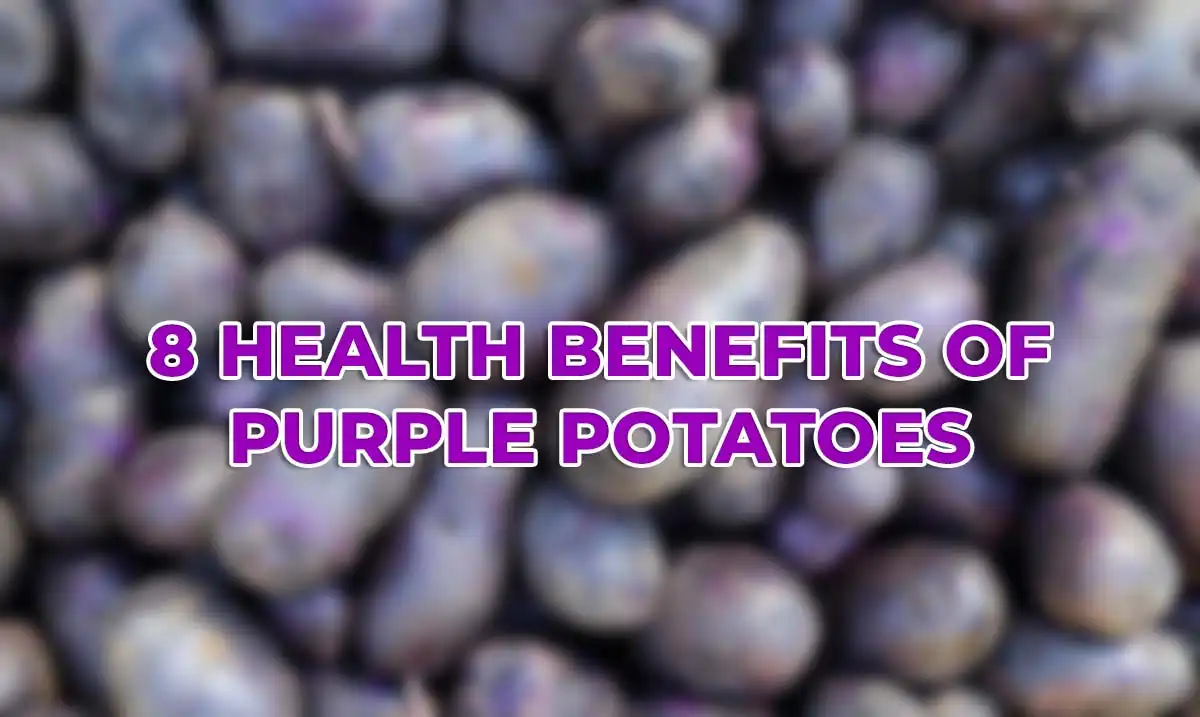Have you ever noticed those vibrant purple potatoes at your local farmers’ market? They’re not just pretty to look at – these colorful spuds pack a serious nutritional punch that might surprise you.
When I first spotted purple potatoes, I thought they were another food gimmick. But after adding them to my diet, I noticed improvements in my energy levels and overall health that made me curious about their benefits.
Purple potatoes aren’t new at all. They’ve been cultivated for thousands of years in South America, where the Incas treasured them as a dietary staple. Now, they’re gaining popularity worldwide for good reason.
Let’s explore what makes these purple gems so special and why you should add them to your shopping list during your next grocery run.
What Are Purple Potatoes?
Purple potatoes are exactly what they sound like potatoes with purple flesh and skin. Their unique color comes from natural plant pigments called anthocyanins, the same compounds found in blueberries and blackberries.
These special potatoes come in several varieties, including Purple Majesty, Purple Peruvian, and Adirondack Blue. Each has slightly different characteristics, but all share that stunning purple hue.
Purple potatoes tend to be smaller than traditional russet potatoes. Their texture is often creamier, and their flavor is more complex slightly nutty with subtle earthy notes.
Purple potatoes can be cooked just like regular potatoes despite their exotic appearance. They’re versatile ingredients for roasting, mashing, baking, or adding to salads.
Why the Color Matters
The vibrant purple color isn’t just for show it signals powerful nutritional benefits. That deep hue comes from anthocyanins, potent antioxidants with numerous health benefits.
Foods rich in anthocyanins may help reduce inflammation, fight free radicals, and protect cells from damage. These natural compounds may play a significant role in preventing chronic diseases.
Interestingly, the concentration of these beneficial compounds in purple potatoes is significantly higher than in white varieties. The deeper the purple color, the higher the anthocyanin content.
When cooking purple potatoes, try to leave the skin on. The skin contains the highest concentration of these beneficial compounds, maximizing the nutritional benefits you’ll receive.
#1: Rich in Antioxidants
Purple potatoes are antioxidant powerhouses. Their vibrant color comes from anthocyanins, which neutralize harmful free radicals in your body and reduce oxidative stress.
Studies show purple potatoes contain two to four times more antioxidants than regular white potatoes. That’s a significant nutritional upgrade just by changing the color of your spuds!
These antioxidants work throughout your body to protect cells from damage. They help maintain healthy tissues and may slow the aging process at a cellular level.
Adding purple potatoes to your regular diet consistently supplies your body with these protective compounds. It’s an easy dietary change with potentially far-reaching benefits.
#2: May Lower Blood Pressure
Research published in the Journal of Agricultural and Food Chemistry found that consuming purple potatoes may help lower blood pressure. This is promising news for those monitoring their heart health.
In one study, participants who ate purple potatoes twice daily for a month experienced a reduction in blood pressure of about 4% without any other dietary changes.
Scientists believe this effect is due to the potatoes’ high concentration of chlorogenic acid and anthocyanins. These compounds help blood vessels relax and improve circulation.
Purple potatoes’ heart-healthy benefits make them an excellent choice for anyone concerned about cardiovascular health or managing hypertension through diet.
#3: Anti-Inflammatory Properties
Chronic inflammation is linked to numerous health problems, including heart disease, diabetes, and arthritis. Purple potatoes contain compounds that may help fight this harmful inflammation.
The anthocyanins in purple potatoes possess natural anti-inflammatory properties. Regular consumption may help reduce inflammatory markers in the body over time.
Research suggests these anti-inflammatory effects could benefit those with inflammatory conditions. They may complement other dietary approaches to managing inflammation.
Remember, whole-food sources of anti-inflammatory compounds, like purple potatoes, provide benefits that isolated supplements often cannot match. Nature’s package is complete and balanced.
#4: Cancer-Fighting Potential
Purple potatoes’ anthocyanins and other phytonutrients have shown promise in laboratory studies for their potential cancer-fighting properties. Research in this area continues to evolve.
These compounds appear to interfere with cancer cell growth and may induce apoptosis (programmed cell death) in specific cancer cells. This is exciting preliminary research in cancer prevention.
A study published in the Journal of Nutritional Biochemistry found that extracts from purple potatoes reduced colon cancer cell proliferation and increased cancer cell death in laboratory tests.
While no single food can prevent cancer, including purple potatoes in a varied, plant-rich diet may contribute to an overall dietary pattern associated with lower cancer risk.
#5: Rich in Essential Nutrients
Beyond their special compounds, purple potatoes are nutritional all-stars. They provide vitamin C, potassium, and B6 – all essential nutrients your body needs.
Potassium, abundant in purple potatoes, helps regulate fluid balance, muscle contractions, and nerve signals. Most Americans don’t get enough of this crucial mineral in their diets.
These colorful tubers also provide good fiber, especially when eaten with the skin on. Fiber supports digestive health and helps maintain steady blood sugar levels.
Purple potatoes contain more protein than other potato varieties. While not a significant protein source, every bit helps contribute to your daily protein needs.
#6: Better Blood Sugar Regulation
Despite being a starchy food, purple potatoes may help with blood sugar management. Their glycemic impact differs from white potatoes in beneficial ways.
Research indicates that the anthocyanins in purple potatoes may improve insulin sensitivity. This helps your body process carbohydrates more efficiently and maintain stable blood sugar.
The fiber content in purple potatoes, especially when eaten with the skin, slows digestion and prevents rapid spikes in blood glucose after meals. This creates a more gradual energy release.
Purple potatoes can be smarter for those monitoring carbohydrate intake than white varieties. They provide steady energy without the dramatic blood sugar fluctuations.
#7: Brain Health Support
The anthocyanins in purple potatoes may benefit cognitive function and brain health. These compounds can cross the blood-brain barrier, directly affecting brain tissue.
Research suggests anthocyanin-rich foods may slow age-related cognitive decline and improve memory. They help protect brain cells from oxidative damage and inflammation.
Some studies indicate these compounds may improve blood flow to the brain. Better circulation means more oxygen and nutrients reach brain cells, supporting optimal function.
Including purple potatoes in your diet is an easy way to boost your intake of these brain-friendly nutrients. They’re part of a growing “brain foods” category worth adding to your plate.
#8: Supports Digestive Health
Purple potatoes contain fiber, which supports a healthy digestive system. One medium potato with skin provides about 3-4 grams of fiber, significantly contributing to daily needs.
This fiber is a prebiotic, feeding beneficial bacteria in your gut microbiome. A healthy gut microbiome is increasingly linked to better overall health and immune function.
Purple potatoes contain resistant starch, especially when cooled after cooking. This type of starch resists digestion and acts like soluble fiber, further supporting digestive health.
Purple potatoes are often well-tolerated for those with sensitive digestion and provide gentle fiber that helps maintain digestive regularity and comfort.
How to Include Purple Potatoes in Your Diet
Adding purple potatoes to your meals is simple and versatile. Try roasting them with olive oil, rosemary, and a sprinkle of sea salt for a delicious side dish.
Mashed purple potatoes make a stunning presentation. Their creamy texture and nutty flavor pair wonderfully with garlic, butter, and herbs for an elevated comfort food.
Cold potato salads featuring purple potatoes look impressive and may provide additional health benefits. Cooling potatoes increases their resistant starch content.
You can also slice and bake them into homemade chips, add them to soups and stews, or bake them like a regular potato with your favorite toppings.
Where to Find Purple Potatoes
Purple potatoes are becoming increasingly available in grocery stores, particularly those with extensive produce sections. Look for them alongside other specialty potatoes.
Farmers’ markets are another excellent source, especially during harvest season. Local farmers often grow varieties you won’t find in commercial supermarkets.
If you enjoy gardening, consider growing your own! Purple potato varieties are available as seed potatoes from many garden centers and online suppliers.
When selecting purple potatoes, look for firm tubers with smooth skin free of sprouts or green spots. Like regular potatoes, store them in a cool, dark place.
A Word of Caution
Despite their many benefits, purple potatoes are still potatoes. Like other potato varieties, they contain carbohydrates and calories, so portion control remains important.
For specific dietary concerns such as diabetes, consult your healthcare provider about including purple potatoes in your meal plan. They may affect individuals differently.
If you’re trying to lose weight, incorporate purple potatoes mindfully. Their nutrient density makes them a good choice, but they should be part of a balanced diet.
Remember that preparation matters! Deep-frying purple potatoes negates many of their health benefits. Opt for healthier cooking methods like baking, roasting, or steaming.
The Bottom Line
Purple potatoes offer a unique combination of nutrition, flavor, and visual appeal, making them worth adding to your culinary repertoire. Their striking color signals their exceptional health benefits.
Switching from regular potatoes to purple varieties is an easy way to boost your antioxidant intake and add nutritional diversity to your diet. Small changes often lead to significant health benefits.
These colorful tubers remind us that nature provides incredible diversity in our food supply. Exploring different varieties of familiar foods can open up new nutritional opportunities.
So, consider reaching for those vibrant purple potatoes next time you’re planning a meal. Your body will thank you for the nutritional upgrade, and your dinner guests will be impressed with the colorful addition to the table.
Have you tried purple potatoes before? What’s your favorite way to prepare them? Share your thoughts and recipes in the comments below!


